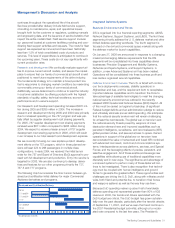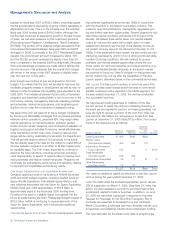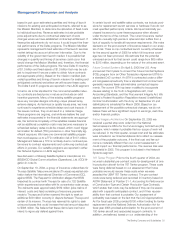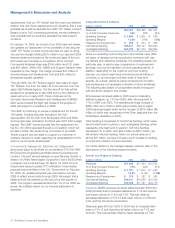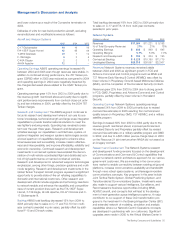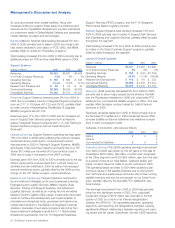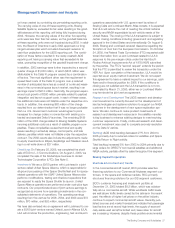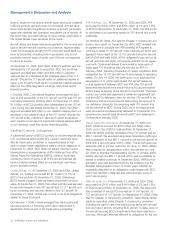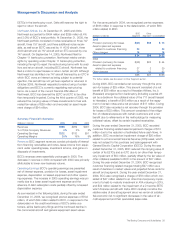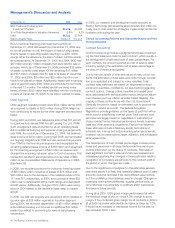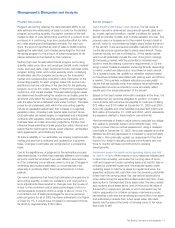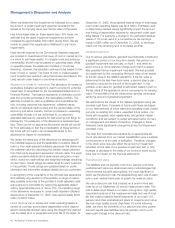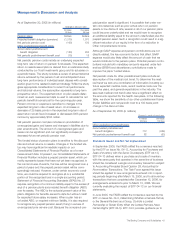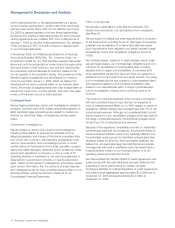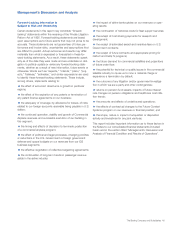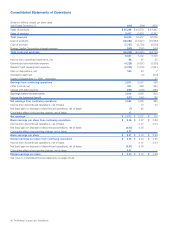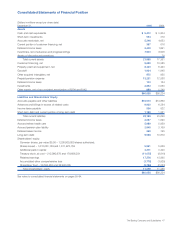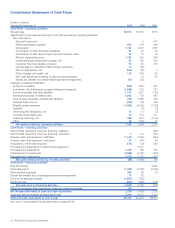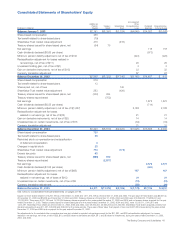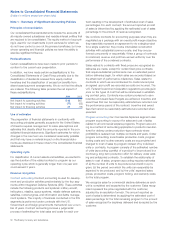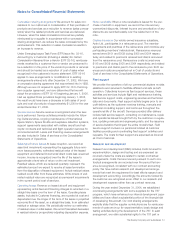Boeing 2005 Annual Report Download - page 43
Download and view the complete annual report
Please find page 43 of the 2005 Boeing annual report below. You can navigate through the pages in the report by either clicking on the pages listed below, or by using the keyword search tool below to find specific information within the annual report.Management’s Discussion and Analysis
Program Accounting
Program accounting requires the demonstrated ability to reli-
ably estimate the relationship of sales to costs for the defined
program accounting quantity. A program consists of the esti-
mated number of units (accounting quantity) of a product to be
produced in a continuing, long-term production effort for deliv-
ery under existing and anticipated contracts. For each pro-
gram, the amount reported as cost of sales is determined by
applying the estimated cost of sales percentage for the total
remaining program to the amount of sales recognized for air-
planes delivered and accepted by the customer.
Factors that must be estimated include program accounting
quantity, sales price, labor and employee benefit costs, material
costs, procured parts, major component costs, overhead costs,
program tooling costs, and routine warranty costs. Underlying
all estimates used for program accounting is the forecasted
market and corresponding production rates. Estimation of the
accounting quantity for each program takes into account sev-
eral factors that are indicative of the demand for the particular
program, such as firm orders, letters of intent from prospective
customers, and market studies. Total estimated program sales
are determined by estimating the model mix and sales price for
all unsold units within the accounting quantity, added together
with the sales for all undelivered units under contract. The sales
prices for all undelivered units within the accounting quantity
include an escalation adjustment that is based on projected
escalation rates, consistent with typical sales contract terms.
Cost estimates are based largely on negotiated and anticipated
contracts with suppliers, historical performance trends, and
business base and other economic projections. Factors that
influence these estimates include production rates, internal and
subcontractor performance trends, asset utilization, anticipated
labor agreements, and inflationary trends.
To ensure reliability in our estimates, we employ a rigorous esti-
mating process that is reviewed and updated on a quarterly
basis. Changes in estimates are recognized on a prospective
basis.
Due to the significance of judgment in the estimation process
described above, it is likely that materially different cost of sales
amounts could be recorded if we used different assumptions,
or if the underlying circumstances were to change. Changes in
underlying assumptions/estimates, or circumstances may
adversely or positively affect financial performance in future
periods.
Our recent experience has been that estimated changes due to
accounting quantity, model mix, escalation, and cost perform-
ance adjustments have resulted in changes over the course of
a year to the combined cost of sales percentages of all com-
mercial airplane programs within a range of plus or minus 1%.
If combined cost of sales percentages for all commercial air-
plane programs for all of 2005 had been estimated to be higher
or lower by 1%, it would have increased or decreased income
for 2005 by approximately $190 million.
Aircraft Valuation
Used aircraft under trade-in commitments The fair value of
trade-in aircraft is determined using aircraft specific data such
as, model, age and condition, market conditions for specific
aircraft and similar models, and multiple valuation sources. This
process uses our assessment of the market for each trade-in
aircraft, which in most instances begins years before the return
of the aircraft. There are several possible markets to which we
continually pursue opportunities to place used aircraft. These
markets include, but are not limited to, (1) the resale market,
which could potentially include the cost of long-term storage,
(2) the leasing market, with the potential for refurbishment
costs to meet the leasing customer’s requirements, or (3) the
scrap market. Collateral valuation varies significantly depending
on which market we determine is most likely for each aircraft.
On a quarterly basis, we update our valuation analysis based
on the actual activities associated with placing each aircraft into
a market. This quarterly collateral valuation process yields
results that are typically lower than residual value estimates by
independent sources and tends to more accurately reflect
results upon the actual placement of the aircraft.
Based on the best market information available at the time, it is
probable that we would be obligated to perform on trade-in
commitments with net amounts payable to customers totaling
$72 million and $116 million at December 31, 2005 and 2004.
Accounts payable and other liabilities included $22 million and
$25 million at December 31, 2005 and 2004, which represents
the exposure related to these trade-in commitments.
Had the estimate of trade-in value used to calculate our obliga-
tion related to probable trade-in commitments been 10%
higher or lower than our actual assessment, using a measure-
ment date of December 31, 2005, Accounts payable and other
liabilities would have decreased or increased by approximately
$5 million. We continually update our assessment of the likeli-
hood of our trade-in aircraft purchase commitments and con-
tinue to monitor all these commitments for adverse
developments.
Impairment review for assets under operating leases and held
for sale or re-lease When events or circumstances indicate (and
no less than annually), we review the carrying value of all air-
craft and equipment under operating lease and held for sale or
re-lease for potential impairment. We evaluate assets under
operating lease or held for re-lease for impairment when the
expected undiscounted cash flow over the remaining useful life
is less than the carrying value. We use various assumptions
when determining the expected undiscounted cash flow. A key
assumption is the expected future lease rates. We also include
assumptions about lease terms, end of economic life value of
the aircraft or equipment, periods in which the asset may be
held in preparation for a follow-on lease, maintenance costs,
remarketing costs and the remaining economic life of the asset
and estimated proceeds from future asset sales. We state
assets held for sale at the lower of carrying value or fair value
less costs to sell.
The Boeing Company and Subsidiaries 41


